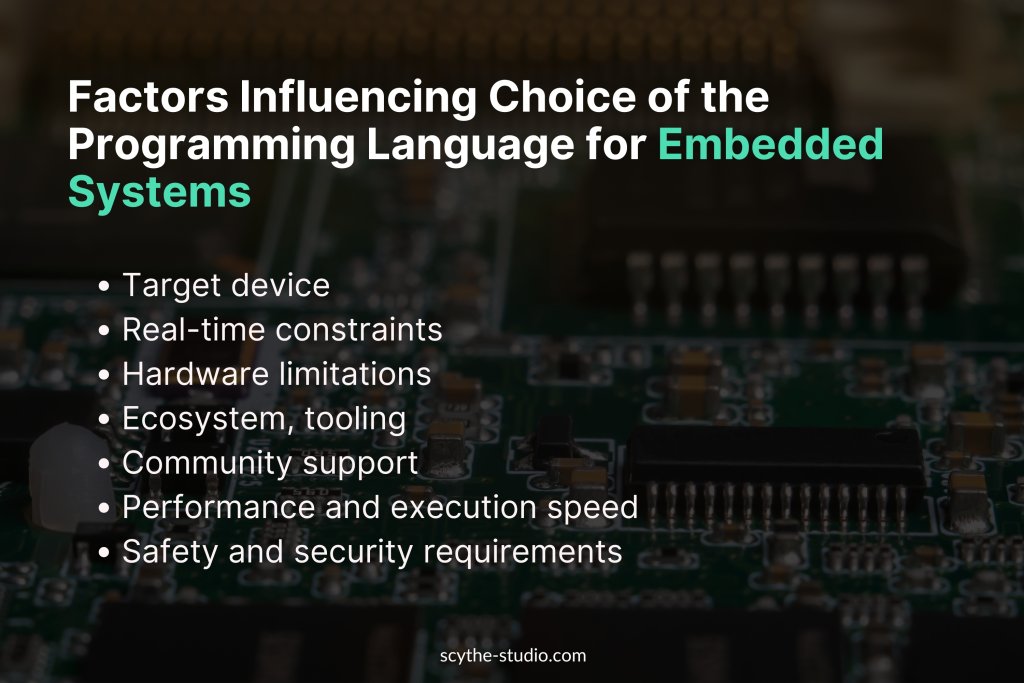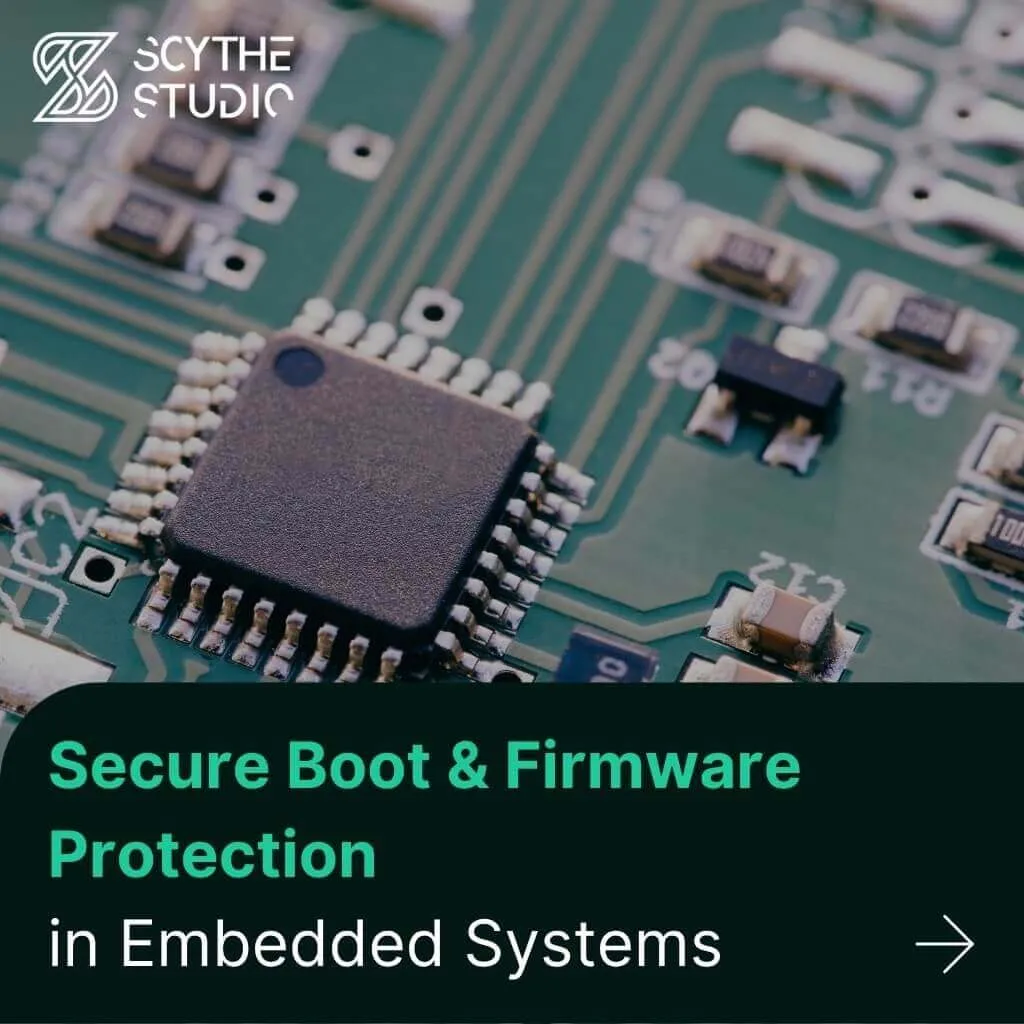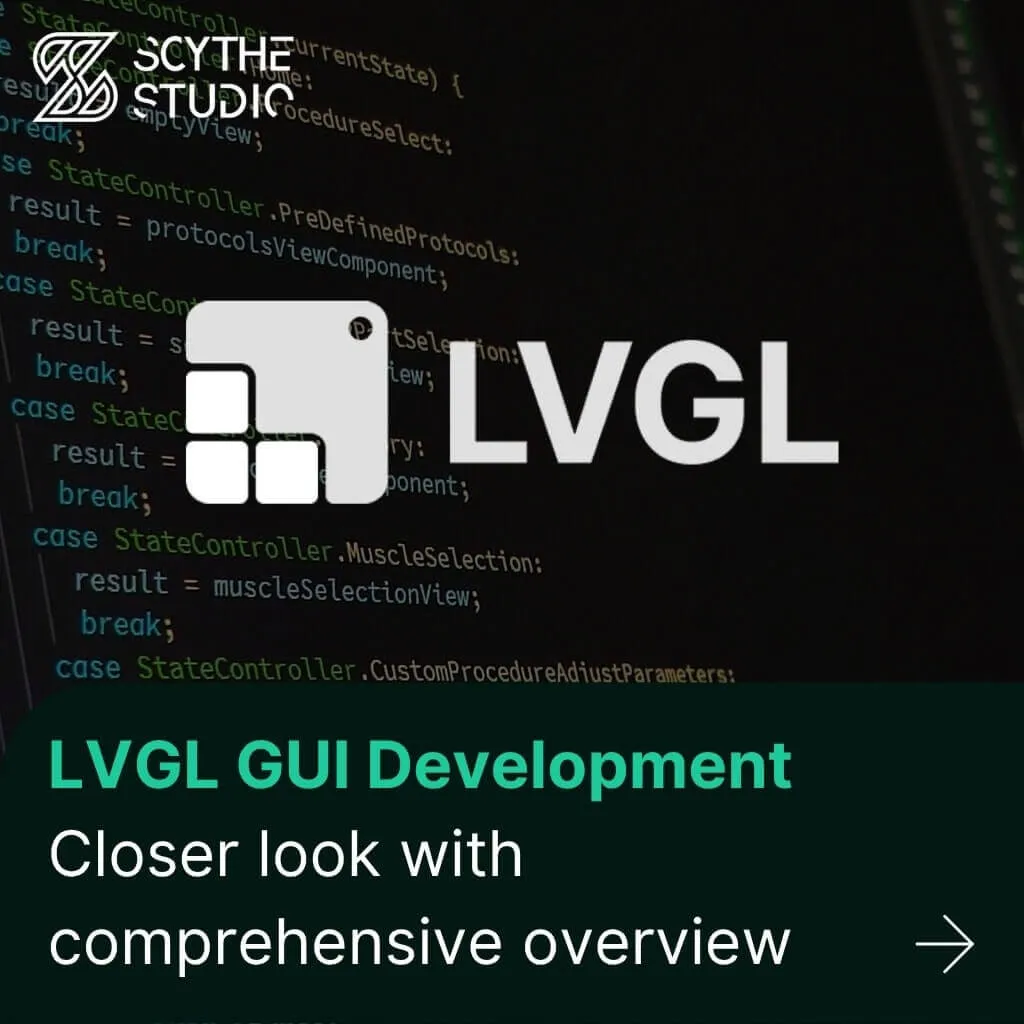
How to use Qt WebAssembly – The Complete Guide with demo
Hey, welcome back to another blog post. Today we’re going to talk about the new Qt WebAssembly. This post will […]
Join us at Qt C++ Warsaw Meetup - 21.08.2025
Sign up for free!
Embedded systems are the backbone of modern technology, powering everything from IoT devices and industrial automation to real-time embedded systems and safety-critical systems. Choosing the right programming language for embedded development matters, as it directly affects memory management, hardware interaction and overall system resources.
At Scythe Studio, we specialise in embedded systems development, helping businesses choose the best programming language for embedded devices based on their needs. Whether you’re developing resource-constrained devices or complex embedded systems, the right language ensures efficiency, security and scalability across different platforms.
C is one of the top embedded systems programming languages, especially for resource-constrained systems that require low memory usage and low-level access. With minimal overhead, it’s widely used in device drivers, real-time operating systems and embedded programming for hardware with strict power consumption limitations.
Unlike some higher-level languages, C gives you direct access to hardware components, making it perfect for embedded software projects where precise memory footprint control is required. But C programming lacks built-in memory safety, which can lead to common programming errors like buffer overflows and memory leaks, increasing development complexity.
| Pros | Cons | Use Cases |
|---|---|---|
| Low-level access to hardware components | No built-in memory safety, prone to buffer overflows | Device drivers, real-time operating systems |
| Minimal overhead and efficient memory footprint | Manual memory management increases development complexity | Low-power, embedded systems with strict resource constraints |
| Wide adoption and large ecosystem | Limited support for modern object-oriented programming paradigms | Systems requiring maximum efficiency in power consumption |

C++ builds upon C by adding object-oriented programming, making it suitable for complex embedded systems that need multiple features while still having low-level control. With the Standard Template Library (STL), exception handling, and modern technology support, C++ is widely used in embedded world applications, especially those running on embedded Linux devices.
Unlike C programming, C++ development has an object-oriented design, so you can write reusable code across different platforms. However, features like dynamic memory allocation and additional runtime overhead in certain C++ abstractions can make it less predictable for real-time embedded systems with strict resource constraints.
| Pros | Cons | Use Cases |
|---|---|---|
| Object-oriented programming with vast libraries | Larger memory footprint compared to C | Complex embedded systems with object-oriented programming |
| Supports Standard Template Library (STL) for complex applications | Some systems may not support dynamic memory allocation on the heap | Industrial automation and IoT devices |
| Better memory safety than C | Longer compile times due to many features | Embedded Linux systems with multiple features |
More about C++ in embedded systems? Check out our post: C++ for Embedded Systems

It’s fair to say that C++ is one of the most commonly chosen programming languages for embedded systems development. The number of active developers, open-source projects, and software already running C++ makes it the best choice in many cases.
C++ is a base language for several GUI frameworks like LVGL or Qt. Find out what is Qt in our article on this topic. Both frameworks allow you to create visual applications if your embedded device consists of a screen. LVGL is better for low-level microcontrollers while Qt is a way more powerful framework, but it also comes with significant overhead.
For real-time embedded systems where every unit of processing power matters, assembly language gives low-level access with minimal overhead. This low-level language allows direct control over system hardware, making it the top choice for device drivers and real-time operating systems with strict timing constraints.
Assembly programming provides absolute control over resources but is highly hardware-specific, which makes portability across different platforms tricky. Plus development using Assembly is slow and error-prone, which is why it’s used only for performance-critical parts of embedded development.
| Pros | Cons | Use Cases |
|---|---|---|
| Low-level language with direct hardware interaction | Difficult to maintain and debug | Performance-critical real-time embedded systems |
| Minimal overhead and maximum performance | Highly hardware-specific, limiting portability | Ultra-low-power microcontrollers |
| Provides absolute control over system resources | Slow development compared to higher-level languages | Device drivers requiring low-level capabilities |
Rust is a new language that’s gaining traction in embedded systems development due to its memory safety and concurrent programming capabilities. Unlike C and C++, Rust eliminates buffer overflows, memory leaks, and other common programming errors, making it suitable for safety-critical systems.
One of Rust’s strengths is that it provides low-level control without sacrificing performance. It’s a great language for embedded systems that require strong security and predictable power consumption. However, it has a smaller ecosystem compared to C programming and C++ development and some embedded systems projects may face toolchain limitations.
| Pros | Cons | Use Cases |
|---|---|---|
| Strong memory safety and concurrent programming support | Relatively new language with smaller ecosystem | Safety-critical systems in automotive and aerospace |
| Eliminates buffer overflows and memory leaks | Steeper learning curve for traditional embedded developers | Memory-safe embedded systems projects |
| No garbage collection, reducing unpredictable system resource usage | Limited toolchain support in some embedded applications | Resource-constrained systems requiring reliability and security |
Rust has a lot of unique advantages and there is a lot of noise around it on the Internet, but the main problem is that it is not so commonly used. We have a lot of people applying to work for us with Rust among their skills and when we ask them why they don’t look for a position where they could code in Rust, they say that there are not enough job offers including Rust.

C# and other higher-level languages are viable for embedded systems that run on real-time operating systems or full-fledged OS environments. Unlike low-level languages, these supported languages offer rapid prototyping, extensive libraries, and object-oriented design.
However C# development comes with a higher memory footprint and requires more resources, so it’s not suitable for real-time embedded systems with strict power consumption constraints.
| Pros | Cons | Use Cases |
|---|---|---|
| Rapid development processes with extensive libraries | Higher memory footprint compared to low-level languages | Embedded development with full-fledged OS environments |
| Garbage collection simplifies memory management | Not suitable for real-time embedded systems | Industrial automation and IoT |
| Strong community support for industrial automation and IoT devices | Requires significant resources to run efficiently | Machine learning applications on embedded platforms |

The term “embedded systems development” is already quite blurred. An embedded device can be a medical robot that runs a high-end PC with Windows or a small sensor with a tiny microprocessor. Both examples fit the definition of embedded systems, as nowadays embedded systems mean “closed devices,” and it doesn’t matter what underlying hardware or operating system they run.
It’s hard for me to type these words, but languages like Dart (for Flutter developers), aforementioned C#, Java, or JavaScript can also be named embedded programming languages in some cases. Before you decide to go easy, pay a lot of attention to choosing the appropriate one.
The choice of embedded programming languages depends on the target hardware. While C and Assembly are necessary for low-level access in microcontrollers, other languages like C++, Rust and C# are suitable for embedded Linux devices that require extensive libraries and object-oriented support.
For real-time embedded systems, low-level capabilities and predictable execution are key. Languages that introduce garbage collection or exception handling may not be ideal.

Some target platforms might not support all the embedded programming languages that we want to use. This applies both in terms of hardware capabilities when it comes to performance in the case of high-level languages, but also when it comes to supporting a particular architecture or toolchain.
Each programming language for embedded development has its own ecosystem. C and C++ have a vast ecosystem and established embedded world tools, Rust is gaining traction due to its safety guarantees. C# and other languages provide ease of use but require specific system hardware support.
At Scythe Studio, we specialise in embedded systems programming and can help you choose the right language for your project. Whether you’re working with resource-constrained devices, complex embedded software or real-time operating systems our team ensures your code will meet performance, security and reliability requirements.
Contact us today to get in touch!
Let's face it? It is a challenge to get top Qt QML developers on board. Help yourself and start the collaboration with Scythe Studio - real experts in Qt C++ framework.
Discover our capabilities
Hey, welcome back to another blog post. Today we’re going to talk about the new Qt WebAssembly. This post will […]

Users of embedded devices – from industrial controllers to consumer electronics – are often unaware of hidden vulnerabilities that threaten […]

Graphical user interfaces (GUIs) are becoming more and more important in embedded devices – from home appliances to medical equipment […]